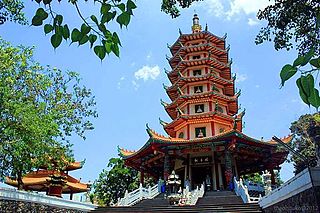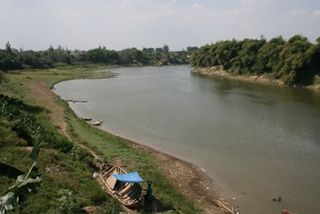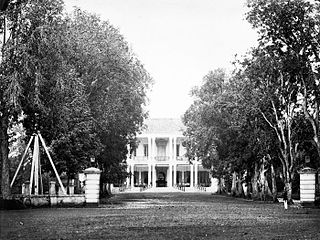
Monorails were used to transport timber from the forests of Central Java, Dutch East Indies (now Indonesia) located in the mountains to the rivers.

Monorails were used to transport timber from the forests of Central Java, Dutch East Indies (now Indonesia) located in the mountains to the rivers.
In 1908 and 1909, the forester H. J. L. Beck built a manually operated monorail of limited but sufficient capacity for the transport of small timber and firewood in the northern Surabaya forest district. In later years, this idea was further developed by L. A. van de Ven, who was a forester in the Grobogan forest district (north of Poerwodadi 7°01′51″S110°55′14″E / 7.03089°S 110.92061°E ) around 1908–1910. [1] [2] He devoted himself to the planning, construction and operation of monorails, [3] especially monorails with larger capacity for heavier transport. His consideration was that the construction and maintenance of monorails in hilly terrain, apart from saving one rail, would be considerably cheaper than the usual two-rail tracks, such as those of the Cepu Forest Railway. [1] As a result, monorails were built by plantation operators and wood processing companies throughout the mountains of Central Java. [3] There were monorail lines in Grobogan, Undakan (in Kudus Regency), Monggot (in Grobogan Regency), and Cepu (in Blora Regency) forest administrations, as well as in Djombang-Babat forest administrations in East Java. In 1919/1920, however, the hand-operated monorails gradually disappeared and were replaced by narrow-gauge railways with steam locomotives as forest utilization changed. [4]
The metal rail of the monorail at Babat (Lage) was laid at a height of about 3 metres on sawn-off tree stumps or on buried posts. On the rail, W-shaped carriages with an extremely low centre of gravity were moved by gravity or by hand. Even in the sharpest curves the swinging carriages could not get out of balance. Even in the rainy season, when the forest roads turned into swamps, the timber transport went undisturbed at lofty heights on the sawn-off trees.

A monorail is a railway in which the track consists of a single rail or a beam. Colloquially, the term "monorail" is often used to describe any form of elevated rail or people mover. More accurately, the term refers to the style of track. Monorail systems are most frequently implemented in large cities, airports, and theme parks.

0-6-0 is the Whyte notation designation for steam locomotives with a wheel arrangement of no leading wheels, six powered and coupled driving wheels on three axles, and no trailing wheels. Historically, this was the most common wheel arrangement used on both tender and tank locomotives in versions with both inside and outside cylinders.

Semarang is the capital and largest city of Central Java province in Indonesia. It was a major port during the Dutch colonial era, and is still an important regional center and port today. The city has been named as the cleanest tourist destination in Southeast Asia by the ASEAN Clean Tourist City Standard (ACTCS) for 2020–2022.

Bojonegoro Regency is a regency in East Java Province of Indonesia, about 110 km west of Surabaya and 73 km northeast of Ngawi. It covers a land area of 2,307.06 km2 and is located in the inland part of the northern Java plain, mainly on the south bank of the Solo River, the longest river in Java. It had a population of 1,209,973 at the 2010 Census and 1,301,635 at the 2020 Census; the official estimate as at mid-2023 was 1,363,058. The administrative centre of the regency is the town of Bojonegoro.

The majority of Indonesia's railways are on Java, used for both passenger and freight transport. There are three noncontinuous railway networks in Sumatra while two new networks are being developed in Kalimantan and Sulawesi. Indonesia has finalized its plan for a national railway network recently. According to the plan, 3,200 km of train tracks that will criss-cross the islands of Sumatra, Java, Kalimantan, and Sulawesi, it has been touted as the most extensive railway project in Indonesia since its independence from the Dutch in 1945. Indonesia targets to extend the national railway network to 10,524 kilometres by 2030. As of September 2022, the network spans 7,032 km.
Purwodadi is a town and a district in Grobogan Regency, of which it is the administrative capital. It is located to the south east of Semarang, the capital of Central Java, Indonesia. It covers an area of 78.12 km2, and had a population of 139,387 at the 2020 Census. It is also well known for tauco, a soya bean sauce, and swieke, a frog legs dish.

PT Kereta Api Indonesia (Persero) (lit. 'Indonesian Railways (State-owned) Limited', abbreviated as PT KAI or simply KAI) is a major railway operator in Indonesia and one of the public railway companies in the country. It is state-owned and pays track access charges. Its headquarters are located in Bandung, West Java. In 2019, KAI carried 429 million passengers and 47.2 million tonnes of cargo.

The Solo River is the longest river in the Indonesian island of Java, it is approximately 600 km (370 mi) in length.

Temanggung Regency is an inland regency in the Central Java Province of Indonesia. It covers a land area of 870.65 km2 and had a population of 708,546 at the 2010 Census and 790,174 at the 2020 Census; the official estimate as of mid-2023 was 808,446, comprising 406,100 males and 402,346 females. Its capital is the town of Temanggung.

Blora is a regency in the northeastern part of Central Java province in Indonesia. Its capital is the town of Blora. The regency is located in the easternmost part of Central Java and borders the Bengawan Solo River and the East Java province. It covers an area of 1,955.83 km2 and it had a population of 829,728 at the 2010 Census and 884,333 at the 2020 Census; the official estimate as of mid-2023 was 901,621, comprising 450,993 males and 450,628 females.

Semarang is a landlocked regency in Central Java province in Indonesia. It covers an area of 1,019.27 km2 and had a population of 930,727 at the 2010 census and 1,053,094 at the 2020 census; the official estimate at mid 2023 was 1,080,648, comprising 538,117 males and 542,531 females. These figures exclude the independent cities of Semarang and Salatiga, which are administratively separate from the regency. The regency's capital is Ungaran, which lies immediately to the south of Semarang City.

The Powelltown tramway was a 3 ft narrow gauge tramway that operated between Powelltown and Yarra Junction, Victoria, Australia, between 1913 and 1945.

The Ambarawa Railway Museum is a museum located in Ambarawa in Central Java, Indonesia. The museum preserves around 21 steam locomotives and focuses on tourism train tours hauled by 3 operational steam engines and a hydraulic diesel engine, using the remains of the closing of the 3 ft 6 in (1,067 mm) railway line.

Surabaya Pasar Turi Station or Surabaya Pasarturi Station (SBI) is the second largest railway station in Surabaya, East Java. It is located near the Pasar Turi market in Bubutan, Surabaya. It is the main departure point of all train from Surabaya which passes through Pantura to the western cities of Java such as Jakarta and Semarang, but trains south and east line from Surabaya departed from Surabaya Gubeng. Since 2014, the station has upgraded railway signal and railroad switch devices from mechanical to electrical type produced by Len Industri.
Most railway lines in Indonesia were constructed during the Dutch colonial rule. After independence in 1945, many lines were abandoned. The current national rail operator, PT Kereta Api Indonesia (Persero), was founded on 28 September 1945.

The Jabodebek LRT or Greater Jakarta LRT is a light rapid transit system in Greater Jakarta, the capital city of Indonesia, as well as the adjacent areas of West Java, within the Jakarta Metropolitan area. It was implemented by the central government, and operated by Kereta Api Indonesia (KAI), the system connects the Jakarta city center with suburbs in Greater Jakarta such as Bogor, Depok and Bekasi, hence its acronym Jabodebek.

Cepu is a district (kecamatan) of Indonesia in Blora Regency, Central Java Province. Its seat is the town of Cepu.

Staatsspoorwegen was a state-owned railway company managed by the Dutch East Indies colonial government. It was absorbed into the present Kereta Api Indonesia after Indonesian independence in 1945. The main competitor was Nederlandsch-Indische Spoorweg Maatschappij (NIS) as private-owned railways company which had standard gauge and cape gauge lines.

Semarang Residency was an administrative subdivision (Residency) of the Dutch East Indies located on the northern coast of Central Java and named after its capital city Semarang. It existed from 1818 to 1942, although its borders were changed many times during that period.

Blora Residency was an administrative division (Residency) of Central Java province of the Dutch East Indies with its capital at Blora, which existed between 1928 and 1931. It was significantly larger than the present-day Blora Regency, as it also contained Grobogan Regency and Purwodadi.